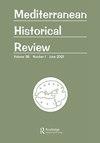Female conversion to Islam: a sample analysis of medieval narratives of the prophetic age
IF 0.2
2区 历史学
Q1 HISTORY
引用次数: 0
Abstract
The question of female conversion to Islam in pre-modern times has received insufficient attention in modern scholarship. This is mostly the result of the methodological problem that shrouds it. One can say with high measures of certainty that in contrast to their male counterparts, the treatment of female converts to Islam in early Islamic sources is almost always in relation to a male figure. It is the premise of the present contribution that female choices to embrace the Islamic creed, although restricted by male authority, deserve greater attention. The present discussion explores female agency in moments of conversion to Islam by focusing on the biographies of three female figures from the time of the Prophet. Read in tandem with additional literary sources, it attempts to locate the medieval (i.e. eighth–thirteenth centuries) context of stories that go back to the very early phases of the Umma – the Muslim Community of Believers.女性皈依伊斯兰教:中世纪先知时代叙事的样本分析
前现代女性皈依伊斯兰教的问题在现代学术界没有得到足够的重视。这主要是笼罩它的方法论问题的结果。人们可以非常肯定地说,与男性相比,早期伊斯兰文献中皈依伊斯兰教的女性所受到的待遇几乎总是与男性有关,尽管受到男性权威的限制,但值得更多关注。本讨论通过关注先知时代三位女性人物的传记,探讨了皈依伊斯兰教时的女性能动性。与其他文学来源一起阅读,它试图找到中世纪(即八至十三世纪)的故事背景,这些故事可以追溯到Umma(穆斯林信徒社区)的早期阶段。
本文章由计算机程序翻译,如有差异,请以英文原文为准。
求助全文
约1分钟内获得全文
求助全文

 求助内容:
求助内容: 应助结果提醒方式:
应助结果提醒方式:


